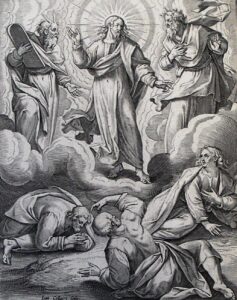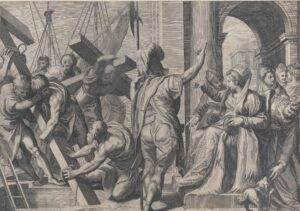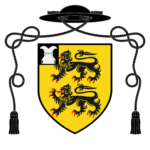A Recapitulated Lent
by Fr. William Rock, FSSP
On the 6th day of August, Holy Mother Church celebrates the Feast of the Transfiguration which is the second time in the liturgical year when this event of Our Lord’s life is made present to the faithful through the sacred signs of the Church’s liturgy and the infused virtue of Faith.

The first was the shared Gospel of the Ember Saturday and the Second Sunday of Lent. Historically, the Transfiguration occurred in the last year of Our Lord’s public ministry and before His final departure from Galilee for Judea and Jerusalem where He would suffer (see Mat 19:1). Our Lord, knowing that at Jerusalem He would undergo His Passion for the benefit of our salvation, took with Him up the mount where He was transfigured the same three Apostles who would be with Him during His Agony in the Garden – Peter, James, and John. As they would soon see Christ suffering in the Garden, Our Lord would give them a glimpse of His glory – a glory which He always has but which He hid so that He could suffer and die for us. This glimpse of His glory was to provide them with a reason not to despair or fear at the time of the Passion. This presentation of the Transfiguration at the start of Lent serves the same purpose for the Faithful as they prepare to celebrate the liturgical commemoration of the Lord’s Passion and Death. In this light, the placing of this commemoration of the Transfiguration near the beginning of Lent can be seen as thematically fitting.
As they were descending the mountain, Our Lord told those with Him: “Tell the vision to no man, till the Son of Man be risen from the dead” (Mat 17:9). As the August Feast of the Transfiguration will always occur after Easter, after the Feast of the Resurrection, it is, as it were, those Apostles making public to the Church, after the Son of Man rose from the dead, what they had witnessed before the Passion when Christ took them “up into a high mountain apart”(Mat 17:1).1 Unlike the commemoration of the Transfiguration at the beginning of Lent, where only the Gospel (and its commentaries in Matins) is concerned with the event, in the August Feast of the Transfiguration, everything in the liturgy manifests it. This difference between these two observances serves to indicate how one presents the not-yet-made-public event and the other the event as publicly proclaimed. There is a fittingness, then, to having these two commemorations of the Transfiguration in the course of the liturgical year.

In a previous article, it was remarked that the Church, at the conclusion of the Octave of Pentecost, seemed not quite ready to leave behind her the mysteries she had been celebrating and meditating upon during Holy Week. There were, it was observed, liturgical recapitulations where pre-Easter mysteries were revisited in light of the Lord’s Resurrection. Following the Pentecost Octave and Trinity Sunday, the Thursday of Corpus Christi recapitulated Holy Thursday and, an octave later, the Feast of the Sacred Heart recapitulated Good Friday. Something similar occurs with the August Feast of the Transfiguration.
There is a tradition which holds that the Transfiguration occurred 40 days before the Crucifixion.2 This being the case, the commemoration at the beginning of Lent is not just thematically fitting but also places this commemoration at nearly the proper historical distance from Good Friday.3 Lent, however, was considered an unfitting time for a festal celebration of the Transfiguration.4 And so, the Feast of the Transfiguration was fixed by counting back 40 days from the Feast of the Exaltation of the Cross, an older feast which is itself a recapitulated Good Friday, one even older than that of the Sacred Heart. The Feast of the Exaltation of the Holy Cross was originally instituted to commemorate the Finding of the True Cross and the Dedication of the Church of the Holy Sepulchre in Jerusalem.5 If the Feast of the Exaltation is a recapitulated Good Friday, and the August Feast of the Transfiguration is seen as a recapitulation of the commemoration of the same at the beginning of Lent, then these 40 days between them serve as a recapitulated Lent.
The first encounter with the Transfiguration was near the start of the 40 days of Lent. Lent itself ended soon after the adoration of the Cross on Good Friday. Forty days after the August Feast of the Transfiguration, the Cross again becomes the focus of the Church’s attention. On Good Friday, the Cross was regarded as that on which Our Savior hung in agony and died for our sins – “Behold the wood of the Cross on which hung the Savior of the world.” In September, unmixed with sorrow and horror, the Cross is exalted, held high as the banner of our salvation.

What has just been presented sheds light onto this time of the Church’s Liturgical Year. Looking at the Church’s calendar during this Time after Pentecost, it can seem that there is no order or structure to it. There are feasts and other liturgical days which, at first glance, seem simply to fill up the remaining time before Advent. But, by understanding the origins of the feasts, their connections with the celebration of the pre-Easter mysteries, and their connections with each other, a structure arises.
Such reflections will also reveal the Mind of the Church to her children, the Faithful, so that they can imitate her. Even now, in August and September, the Church keeps before her, and before her Faithful, the great price of redemption, the sufferings of Our Lord, with recapitulations of the Transfiguration, the 40 days of Lent, and Good Friday though viewed now in the light of the Resurrection. There can be the danger that the further the Faithful move away from Lent and Holy Week, what so impressed their minds then will begin to slip and grow dull. And, as these impressions and considerations grow dull, so too will the hearts which were aflame at Easter cool or even grow cold. By these post-Easter recapitulations, Holy Mother Church invites her children to renew in their minds the impressions made during Lent and Holy Week and enflame again their hearts.
May we all, then, follow this lead of Our Mother and prove ourselves true children of the Church, children after her own mind and heart.
Fr. William Rock, FSSP was ordained in the fall of 2019 and is currently assigned to Regina Caeli Parish in Houston, TX.
- See Guéranger, Prosper.The Liturgical Year, vol. 13 (Time after Pentecost Book 4). Trans. The Benedictines of Stanbrook Abbey. (Fitzwilliam: Loreto Publications, 2000), p. 271-272.
- “Originally, the feast of the Transfiguration was observed in February [in the Byzantine tradition]. However, since this joyful feast fell during the time of the Great Fast [i.e., Lent], its celebration was not in keeping with the spirit of fasting and penance. Therefore, it was transferred to the 6th of August. Why this day? The historian Eusebius and St. John Damascene are of the opinion that the Lord’s Transfiguration took place forty days before the death of Christ. Thus holy Church, in keeping with this opinion, transferred this feast from the month of February to the 6th of August, because forty days later, September 14th, is the feast of the Exaltation of the Holy Cross – the commemoration of the passion and death of Christ.” – Katrij, Julian. A Byzantine Rite Liturgical Year. Trans. Wysochansky, Demetrius. (Detroit: Basilian Fathers Publication, 1983), p. 421. But there are other traditions regarding the historical date of the Transfiguration. Dom Guéranger (1) wrote, “more than one doctor of sacred rites [Sicard. Cremon. Mitrale, ix. 38; Beleth. Rationale, cxliv.; Durand. vii., xxii., etc.] affirms that” the Transfiguration occurred historically on August 6th. The Orthodox priest Thomas Hopko presents, in his The Orthodox Faith, Volume II-Worship, the Church Year, Transfiguration, that the Transfiguration historically “took place at the time of the Festival of Booths” (September-October). If one accept this position, one would have to take into account that Jesus was in Jerusalem for the Feast of Booths which occurred prior to the Passion (see John 7:1, 9-10) and this would have to be the one, in this dating, associated with the Transfiguration as the synoptic Gospels, which recount the Transfiguration, only detail about the last year of Our Lord’s public ministry, although a date of early August might not be out of bounds thus harmonizing these two other positions. The liturgical tradition of the Latin and Greek Churches, in first placing a commemoration of the Transfiguration in the February timeframe, either fixed or moveable, argues for the position of Eusebius and St. John Damascene (the Murbach Lectionary, the second oldest lectionary of the Roman Tradition [~ A.D. 800], attest to the pericope of the Transfiguration being read on Ember Saturday of Lent). However, a West Syriac Jacobite Lectionary (Sachau_322) attests that in this tradition the Transfiguration is named the “Feast of Tents [Booths]” while celebrating the feast on the 6th of August.
- From the Second Sunday of Lent to Good Friday there are, inclusively and counting Sundays, 34 days. From Ember Saturday of Lent to Good Friday there are, inclusively and counting Sundays, 35 days. 40 days prior to Good Friday, according to the same counting method, would be the Monday of the First Week of Lent. Why, then, is the Lenten commemoration of the Transfiguration not kept on the Monday of the First Week of Lent but rather on the Ember Saturday and Second Sunday of Lent? According to Sts. Matthew and Mark, the Transfiguration took place on a 7th day. According to St. Luke, it took place on an 8th day (see here, here, here, and here). There is an affinity, then, for celebrating the Transfiguration on a Saturday (the 7th Day) and/or on the Christian Sunday (the 8th Day).
- The commemoration of the Transfiguration at the beginning of Lent is not festal. As was stated above, only the Gospel (and the Matins commentaries) are concerned with this event and the liturgy of the day reflects the season of Lent.
- In the Roman Liturgy, the commemoration of the Finding of the Holy Cross became traditionally associated with May 3rd and the September 14th date with the recovery of the Relic of the True Cross by the Roman Emperor from the Persians.
August 6, 2023









